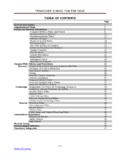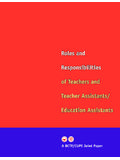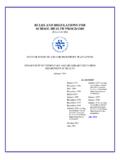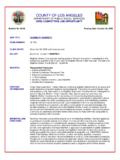Transcription of Migration and Filipino Children Left-Behind: A …
1 1 Migration and Filipino Children left - behind : A Literature Review By: Melanie M. Reyes Miriam College Women and Gender Institute (WAGI) for the United Nations Children s Fund (UNICEF) Introduction People have been on the move since human life began. Migration is neither a new phenomenon, a failure of development, nor a substitute for individuals move as part of their effort to improve their lives and the lives of their families, to learn new skills, to gain new experiences, to find a job or to flee insecurity, disaster or famine.
2 Migration is an economic, social and political process that affects those who move, those who stay behind , and the places where they go. 1 And with the advent of globalization, labor Migration has become a worldwide phenomenon. People are crossing borders to search for better job opportunities and to provide a better future for their families. Along this development is the plight of more Children being left behind by either one or both parents, leaving them to the care of extended family members or friends. In Asia, the Philippines is the major supplier of labor migrants to over 100 countries and the leading female migrant sending countries along with Indonesia.
3 More than 8 million2 (10%) out of the 85 million Filipinos were working or living abroad. While over 72% of total migrants from Philippines were women Many of these women work as domestic helpers, nurses, caregivers, and entertainers. With this huge number of Filipino migrants (and still more) living the country temporarily (or permanently4), a more pressing concern is with regards to Children left behind . Though there is no systematic data on the number of Children left behind , it is estimated to be 9 million or 27% of the total The impact of Migration varies - ranging from economic benefits not only for the family but the country in generally through its remittances to the security and well being of the family of migrants.
4 But a major concern here is the social costs of Migration specifically to the Children left behind . A study by Scalabrini reveals that there is a variation in terms of gender roles when women migrate compared to men. When men migrate, the left - behind wives indeed assumed more responsibilities with their dual roles as fathers and 1 Moving Out of Poverty Making Migration Work Better for Poor People , Department for International Development (DFID), March 2007 2 Stock Estimate of Overseas Filipinos (2005), Commission on Filipinos Overseas, Republic of the Philippines 3 HUGO, Graeme, Migration in the Asia-Pacific Region , (2005)
5 , Global Commission on International Migration , 4 Especially true for women who would like to escape their difficult marriage 5 Based on the compilation and study of the coalition of NGOs and advocacy groups. 2mothers. But when women migrate, it appears that families go through more adjustments this is not surprising because changes in women s roles often have more implications for the family than changes in men s roles. If women assume men s responsibilities when the men are not around, men do not as readily take up care giving. (Scalabrini, Hearts Apart, 2003).
6 This interchanging of gender roles in the family could also impact positively or negatively depending on how the father left behind accepts his new role. Parental absence creates displacement, disruptions and changes in care giving arrangement. There is always an emotional aspect that goes along with parents leaving their Children , especially for long periods of time. Nevertheless, it is also a relief to have the extended family looking after the Children left - behind . However, it cannot negate the fact that the Children are longing for the love and care of their biological parents.
7 Who are the Children ? Using the definition of the Convention on the Rights of the Child (CRC), a child means every human being below the age of eighteen who are likewise needing protection against all forms of discrimination. Under the Convention, the parents have the moral obligation and responsibilities for the upbringing and development of the Children . The gravity of the impact of Migration on Children varies depending on their situation. Children affected by Migration can be categorized in the following (a) Children as migrants, (b) Children of inter-racial marriages or relations, and (c) Children left behind by migrant More than three thousand Filipino workers leave the country everyday as overseas contract workers7, hence transnational family has become a norm in the Philippines.
8 There really is no exact data on the number of Children affected by Migration but based on several studies done by nongovernmental organizations and local government organizations in Manila, there are approximately 9 million Filipino Children under the age of 18 who are left behind by one or both parents to work tentatively or live permanently abroad. General Impact on Children Children have a different level of acceptance or tolerance of the situation depending on their cognitive development 8. For young Children , they only see Migration as a form of abandonment of their parents; while adolescents may either be receptive or resentful.
9 Related articles on Children left behind also focus on the effects of mother s absence to Children , where Children have varied reactions to Migration situation depending on the 6 Dizon, A onuevo and A onuevo, 2002 7 From the lecture of Ms. Vivian Tornea of Overseas Welfare Workers Administration during the Summer Institute on Migration , Miriam College, May 2008 8 Carandang, 2007 3age of the child for pre-school Children (0-5 years old), the absence of mothers is somewhat easily accepted since no bonding has yet been established but the adjustment for those Children ages 6-16 years of age is more difficult because they had already known and established affection with their Compared to public perceptions about the negative impact of Migration to Children , most research studies reveal a different perspective.
10 Several studies ( Cruz, 1987; Asis, 2000 Parre as, 2006; Bryant, 2007) conducted did not show a big difference in terms of attitudes, behaviors, and values between Children of migrants and non migrants. This was also validated by the 2003 Children and Families Study of Scalabrini conducted in selected areas in Luzon (NCR, Bulacan, Cavite, Laguna), Visayas (Cebu and Negros Occidental), and Mindanao (Davao). There are several factors that may negatively or positively affect the formation and personal development of the Children : 1. Global parenting It was highly recognized that the transmission of values, including spiritual formation, from one generation to the next is one of the major responsibilities vested in the family.

















